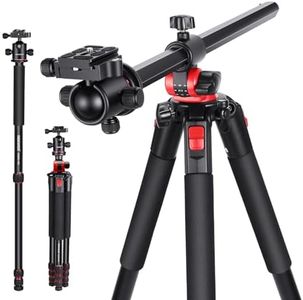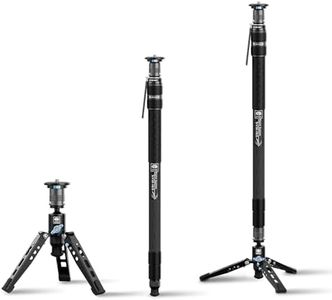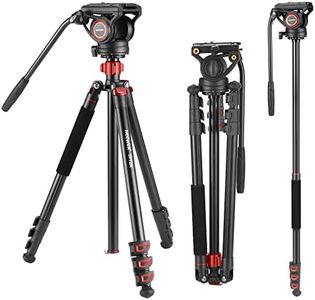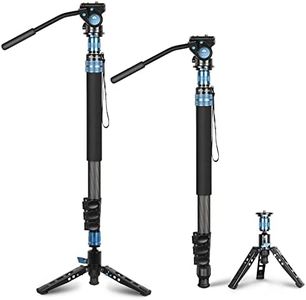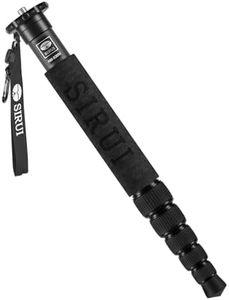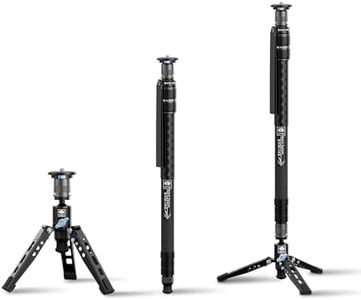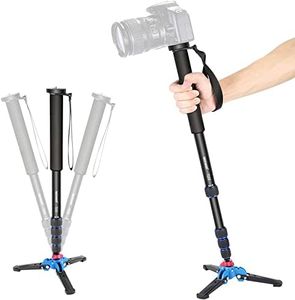We Use CookiesWe use cookies to enhance the security, performance,
functionality and for analytical and promotional activities. By continuing to browse this site you
are agreeing to our privacy policy
10 Best monopods
From leading brands and best sellers available on the web.Buying Guide for the Best monopods
Choosing the right monopod is an important step for anyone interested in stabilizing their camera, whether for photography or videography. Unlike tripods, monopods offer a balance between stability and mobility, making them ideal when you need support but also want to move quickly. To find the best monopod for your needs, you should consider where you'll use it, the type of camera you have, and how much gear you plan to attach. By understanding the key features, you can make an informed choice that enhances your shooting experience.MaterialThe material of a monopod greatly influences its weight, durability, and price. Common materials include aluminum and carbon fiber. Aluminum is sturdy and affordable but tends to be heavier. Carbon fiber is lighter and resists vibration better, making it ideal for travel and long shooting sessions, but it's usually more expensive. If you plan to carry your monopod for long distances or want quick setup, carbon fiber might be more comfortable, while aluminum works well for occasional or stationary use.
Maximum Load CapacityThis specification tells you how much weight a monopod can safely support. It’s crucial because your camera and any accessories must not exceed this limit. Monopods come with different load capacities, often ranging from a few kilograms to ten kilograms or more. If you use a lightweight camera or smartphone, a lower capacity will suffice. However, if you're using DSLRs or heavy lenses, look for a higher load rating to ensure stability and safety for your equipment.
Height RangeThe height range of a monopod includes both its maximum extended height and its minimum collapsed height. Maximum height decides how comfortably you can shoot while standing, while the collapsed size impacts how portable it is for travel. Tall photographers or those who want to shoot at eye level should consider a monopod with higher maximum height. If you often pack light or travel, a monopod that collapses small will be easier to carry.
Leg SectionsMonopods are divided into several extendable sections. The number of sections affects both portability and set-up time. Fewer sections usually mean faster deployment and better stability, but the monopod will be longer when stored. More sections provide a more compact folded size but may take slightly longer to extend and could be less stable if they're thin. Pick fewer sections for quick, stable use, and more for increased portability at the expense of tiny extra setup time.
Locking MechanismEach leg section has a locking mechanism to keep it stable. The main types are twist locks and flip locks. Twist locks offer a sleeker design and are less likely to catch on things, while flip locks can be quicker and more intuitive for some users. Consider which feels more comfortable and secure in your hand, especially if you'll make frequent adjustments.
Foot DesignThe bottom of a monopod may have different types of feet: fixed rubber feet, retractable spikes for outdoor use, or even small fold-out legs for extra stability. For general indoor and outdoor use, rubber feet suffice and prevent slipping. If you plan to use the monopod on rough terrain, a spike or tripod-style foot can provide added security. Choose the foot design based on where you expect to shoot most often.
Head CompatibilitySome monopods come with a built-in head (the mount for your camera), while others only provide a basic screw mount. A head allows for easier angle adjustments. Think about whether you'll need to quickly tilt or pan your camera. For basic photography, a simple mount is often enough, but for video work or wildlife photography, a monopod with an adjustable head is useful. Make sure the head type matches your camera's mounting system.
WeightA monopod's weight influences how comfortable it is to carry around for long periods. Lightweight designs are easier for travel, but very light monopods might not feel as stable with heavy camera gear. Heavier monopods can offer more balance and resistance to wind but can become tiring to hold. Choose a weight that complements your physical comfort and the nature of your shoots.

